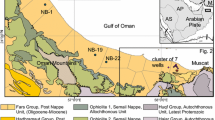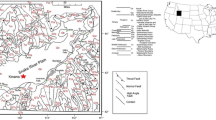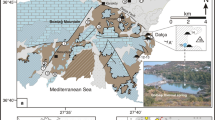Abstract
The Kesenözü thermal springs are located in northwestern Turkey, about 10 km south of Seben. The springs emerge from a fracture zone created by strike-slip faulting that strikes north–northwest, along the Hamamboğazi Creek, in northwestern Anatolia. The reservoir comprises a steeply dipping fracture zone and deep, feeding aquifers hosted by limestones and conglomerates of the Kesenözü Formation. Eight springs and one shallow well discharge thermal water at a total rate of about 44 l/s with temperatures between 42 and 78 °C. The waters are of neutral pH, NaHCO3 type. The meteoric origin of the spa waters is evident from their chemical and isotopic (18O, 2H, 3H) compositions. The thermal system is driven by deep-reaching advective flows where rainwater becomes heated on descent, and after deep paths ascend along fractures that act as hydrothermal conduits. It can be described as an advective geothermal system. Silica (chalcedony) geothermometry indicates equilibrium temperatures between 89 and 94 °C. A recently drilled deep well encountered similar temperatures at about 2 km depth. The minimum heating power potential (direct use) of the fracture zone reservoir is about 10 MWth.









Similar content being viewed by others
References
Andrews N, Fontes JC, Aranyossy JF, Dodo A, Edmunds MW, Joseph A, Travi Y (1994) The evolution of alkaline groundwaters in the continental intercalaire aquifer of the Irhazer Plain, Niger. Water Resour Res 30(1):45–61
APHA (1989) Standard methods for examination of water and wastewater. American Public Health Association American Water Works Association and Water Pollution Control Federation, 17. In: Clesceri L, Greenberg AE, Trussell RR (eds) APHA publication. Washington D.C, USA, p 1134
Arnorsson S, Sigurdsson S, Svarsson H (1982) The chemistry of geothermal waters in Iceland I. Calculation of aqueous speciation from 0 °C to 370 °C. Geochimica Cosmochimica Acta 46:1513–1532
Bjarnason JO (1994) The speciation program WATCH, version 2.1. Orkustofnun, Reykjavik, p 7
Canik B (1970) Bolu–Seben–Kesenözü kaplicasi su tahlil raporu, MTA report no. 87729, MTA, Ankara, Turkey (in Turkish)
Canik B (1980) The hydrogeology investigation of Bolu thermal water springs. PhD thesis, University of Selcuk, Faculty of science, Konya, Turkey (in Turkish)
Canik B, Pasvanoğlu S (2003) Hydrogeological and geothermal Investigation of the Sarot Spa (Bolu-Mudurnu) and surroundings proceedings 38th international conference of Societe Internatinale des Techniques Hydrothermales and The 56th annual meeting of the Balneological Society of Japan, September 25–October 1. Beppu, Japan, pp 156–165
Canik B, Pasvanoğlu S (2005) Seben (Bolu)–Pavlu kaplıca kaynaklarının hidrojeoloji ve hidrojeokimyasal incelemesi. II. National Hydrological Isotope techniques. Ankara, Turkey, pp 241–256
Craig H (1961) Isotopic variations in meteoric waters. Science 133:1702–1703
Didik S (1992) Kesenözü kaplicasi su analizi raporu, MTA report no. 924, MTA, Ankara, Turkey
Engin B (2011) Bolu–Seben–Pavlu BSK-1 kuyusu analiz raporu, MTA report no 84, MTA, Ankara, Turkey
Engin B, Sevim RC, Kar H, Manav E (2010) Bolu ve civarı jeotermal enerji aramaları, kuyu bitirme logu. MTA report, MTA, Ankara, Turkey
Erisen B, Unlu MR (1980) Ankrara, Cubuk, Kizilcahamam ve Kazan çevresinin jeolojisi ve jeotermal enerji olanaklari (in Turkish). MTA report no. 9949, MTA, Ankara, Turkey
Erol O (1955) Köroğlu-Isikdağlari volkanik kütlesinin orta bölümleri ile Beypazari-Ayas arasindaki Neojen havzasinin jeolojisi hakkindaki rapor (in Turkish). MTA report no. 2279, MTA, Ankara, Turkey
Fournier RO (1973) Silica in thermal waters. Laboratory and field investigations. In: Proceedings of the international symposium on hydrogeochemistry and biochemistry, Tokyo, Japan I. Clark Co., Washington D.C., pp 122–139
Fournier RO (1991) Water geothermometers applied to geothermal energy. In: D’Amore F (ed) Applications of geochemistry in geothermal reservoir development. UNITAR/UNDP Publication, Rome, pp 37–69
Giggenbach WF (1988) Geothermal solute equilibrium. Derivation of Na–K–Mg–Ca geoindicators. Geochimica Cosmochimica Acta 52:2749–2765
Giggenbach WF (1991) Chemical techniques in geothermal exploration. In: D’Amore F (ed) Application of geochemistry in geothermal reservoir development. UNITAR/UNDP, Rome, Italy, pp 119–144
Giggenbach WF, Glover RB (1992) Tectonic regime and major processes governing the chemistry of water and gas discharges from the Rotorua geothermal field, New Zealand. Geothermics 21:121–140
Gulec N (1994) Geochemistry of thermal waters and its relation to the volcanism in Kizilcahamam Ankara Area, Turkey. J Volcanol Geoth Res 59:295–312
Henley RW, Ellis AJ (1983) Geothermal systems ancient and modern: a geochemical review. Earth Sci Rev 19:1–50
Hochstein MP, Caldwell G (1985) Heat source characteristics of some warm and hot spring systems in China and Thailand. Transactions Geothermal Resources Council 9 (Int. Volume), pp 557–562
Hochstein MP, Zhongke Y, Ehara S (1990) The Fuzhou geothermal system (People’s Republic of China): modeling study of a low-temperature fracture-zone system. Geothermics 19:43–60
Hochstein MP, Zheng K, Pasvanoglu S, Vivian-Neal P (2013) Advective (heat sweep) geothermal systems. In: Proceedings 38th workshop on geothermal reservoir engineering, Stanford University
Kalafatcioğlu A, Uysalli H (1964) Beypazari–Nallihan ve Seben civarinin jeolojisi. Bulltein of MTA, MTA, vol 62, Ankara, Turkey, pp 1–11 (in Turkish)
Kazanci N (1980) Seben (Bolu) güneyi, Kesenözü, Kizilöz bölgesinin jeolojisi ve sedimentolojisi. The Scientific and Technical Research Council of Turkey, TBAG 314, Ankara, pp 1–246 (in Turkish)
Keller J, Jung D, Eckhardt FJ, Kreuzer H (1992) Radiometric ages and chemical characterization of the Galatean andesite massif Pontus, Turkey. Acta Volcanologica 2:267–276
Kharaka YK, Mariner RH (1988) Chemical geothermometers and their application to formation waters from sedimentary basins. In: Naeser ND, McCulloch T (eds) Thermal history of sedimentary basins. Springer, New York, pp 99–117
Kharaka YK, Lico MS, Law LM (1982) Chemical geothermometers applied to formation waters. Gulf of Mexico and California Basins. American Association Petroleum Geologists Bulletin, vol 66
Lambrakis N, Zagana E, Katsanou K (2013) Geochemical patterns and origin of alkaline thermal waters in Central Greece (Platystomo and Smokovo areas). Environ Earth Sci 69:2475–2486
Mazor E (1991) Applied chemical and isotopic groundwater hydrology. Halstead Press, New York
Ministerialblatt (1968) für das land Nordrhein-Westfalen, Ausgabe A, 21 Jahrgang Nummer 11, 27 August, Düsseldorf-Germany
Muffler PJ (ed) (1978) Assessment of geothermal resources of the United States. US Geological Survey Circular 790, United States Geological Survey, Utah, USA
Nuffield EW (1966) X-Ray diffraction method. Wiley, New York, pp 303–321
Ongur T (1977) Kizilcahamam GB’sinin volkanolojisi ve petrolojisi (in Turkish). Geol Bull Turkey 20:1–12
Pasvanoğlu S (2001) Hydrogeochemistry and utilization study of Bolu–Seben geothermal field, Turkey. Geothermal Diploma report, Geothermal Institute, University of Auckland School of Engineering, Auckland, New Zealand
Pasvanoğlu S (2012) Hydrogeochemical study of the thermal and mineralized waters of the Banaz (Hamamboğazi) area, Western Anatolia, Turkey. Environ Earth Sci 65:741–752
Pasvanoğlu S, Arıgün Z (2001) Hydrogeological investigation of the mineral waters of Kizılcahamam Acısudere Greek. Geological Symposium of Firat (ELAZIĞ) University, Elazığ, pp 12–16
Piper AM (1944) A graphic procedure in geochemical interpretation of water analyses. Am Geophys Union Trans 25:914–923
Pürschel M, Gloaguen R, Stadler S (2013) Geothermal activities in the Main Ethiopian Rift: Hydrogeochemical characterization of geothermal waters and geothermometry applications (Dofan-Fantale, Gergede-Sodere, Aluto-Langano). Geothermics 47:1–12
Reyes AG (2010) Assessing the flow of thermal waters in low-temperature mineral spring systems in the South Island, New Zealand. In: Proceedings World Geothermal Congress, Bali, Indonesia
Reyes AG, Christenson BW, Faure K (2010) Sources of solutes and heat in low-enthalpy mineral waters and their relation to tectonic setting. J Volcanol Geoth Res 192:117–141
Rosen MR, Jones S (1998) Controls on the groundwater composition of the Wanaka and Wakatipu basins, Central Otago, New Zealand. Hydrogeol J 6:264–281
Sahinci A (1970) Mudurnu kaplicasi hidrojeoloji etudu. MTA report no. 4367, MTA, Ankara, Turkey (in Turkish)
Taka M, Şener M, Gevrek AI (2001) Seben–Gerede–Kıbrıscık (Bolu)–Beypazarı–Çamlıdere–Güvem (Ankara) alanında yüzeylenen Üst Miyosen volkanikleri altındaki birimlerin enerji hammadde potansiyeli, MTA report no. 10440, MTA, Ankara, Turkey (in Turkish)
Tonani F (1980) Some remarks on the application of geochemical techniques in geothermal exploration. In: Proceedings, advanced. European geothermal research, 2nd symposium, Strasbourg, France, paper 428–443
Turkunal S (1963) Geology of the area between Nallihan, Mudurnu, and Seben. Geol Bull Turkey 1–2:55–83
Unlu MR, Balkas O (1975) Kesenözü kapIicasi-Belenoren (Ankara-Bolu ili) alanın jeolojisi ve geothermal energy olanakları. MTA report no 2595, MTA, Ankara, Turkey (in Turkish)
Watson A, Maunder BR (1982) Geothermal resource assessment for power station planning. In: Proceedings 4th New Zealand geothermal workshop, University of Auckland, New Zealand, pp 75–79
Wedding H (1954) 56/2 Mihaliçik, 39/4 Nallahanve 39/2 Bolu paftalarinda yapilan linyit aramalari hakkinda MTA report No 2662. MTA, Ankara
Acknowledgments
This work was financially supported by the Research Foundation of the Kocaeli University (Bap Grant No: 2000/21). The author thanks Manfred P. Hochstein for his critical review and comments on the manuscript. The author also likes to thank the editor and the anonymous reviewers for their critical, kind and constructive comments which improved the manuscript.
Author information
Authors and Affiliations
Corresponding author
Rights and permissions
About this article
Cite this article
Pasvanoğlu, S. The Seben–Kesenözü low-temperature geothermal prospect, NW Turkey: study of an advective geothermal system. Environ Earth Sci 74, 363–376 (2015). https://doi.org/10.1007/s12665-015-4041-3
Received:
Accepted:
Published:
Issue Date:
DOI: https://doi.org/10.1007/s12665-015-4041-3




